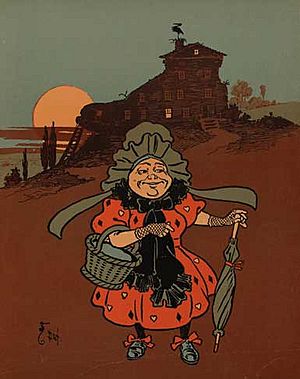There was an Old Woman Who Lived in a Shoe facts for kids
Quick facts for kids "There Was an Old Woman Who Lived in a Shoe" |
|
|---|---|

Illustration by W. W. Denslow, from a 1901 edition of Mother Goose
|
|
| Nursery rhyme | |
| Published | 1794 |
| Songwriter(s) | Unknown |
"There was an Old Woman Who Lived in a Shoe" is a very famous English nursery rhyme. It tells the story of an old woman who has many children. People have wondered for a long time what the rhyme means and where it came from. Some think the old woman might be a real person from history who had a big family. Others even suggest it could be about King George II!
Contents
The Old Woman in the Shoe Rhyme
This popular rhyme has been around for a long time. It is known by many children and adults. The rhyme is a short poem that tells a simple story.
What Are the Lyrics?
The most common words for the rhyme are:
There was an old woman who lived in a shoe.
She had so many children, she didn't know what to do.
She gave them some broth without any bread;
Then whipped them all soundly and put them to bed.
Different Versions of the Rhyme
The rhyme has changed a bit over the years. The very first printed version was in a book called Gammer Gurton's Garland in 1794. It had a slightly different last line:
She whipp'd all their bums, and sent them to bed.
Many other versions were printed in the 18th and 19th centuries. In 1978, Marjorie Ainsworth Decker published a Christian version. It changed the ending to be more gentle:
There was an old woman
Who lived in a shoe,
She had so many children,
And loved them all, too.
She said, "Thank you Lord Jesus,
For sending them bread."
Then kissed them all gladly
and sent them to bed.
Who Was the Old Woman?
People have always been curious about who the old woman in the shoe might be. There are a few ideas about her true identity.
Possible Real-Life Inspirations
One idea is that the old woman represents a real historical woman. This woman would have had a very large family. People often tried to match the rhyme to women known for having many children.
King George II as a Theory
Another interesting idea is that the rhyme is not about a woman at all. Some people think it might be about King George II (who lived from 1683 to 1760). This theory suggests the "shoe" could represent the country. The "children" might be his many subjects or even his political problems.

